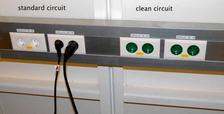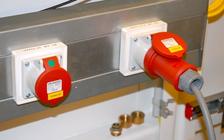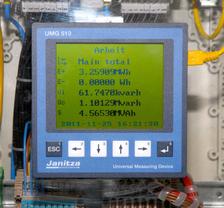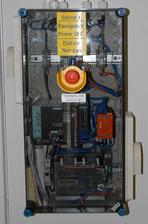Fig. 1: Electrical sockets 230 V / 16 A
The following electrical sockets are available:
a. 230 V / 16 A (see Fig. 1)
b. 400 V / 16 A (see Fig. 2)
c. 400 V / 32 A
d. 400 V / 63 A (only available in a few hutches)
We have two separate electric circuits, which are fed from different power stations, a „standard circuit“ and a „clean circuit“. The „clean circuit“ can be identified by the green sockets. All electrical devices which might influence the quality of the circuit in a negative way like phase shifts, harmonics etc. must be connected to the „standard circuit“.
Each experimental hutch and the corresponding control hutch have two sub-distributions, one for the normal circuit and one for the clean circuit (see Fig. 3). The quality of the „clean circuit“ can be controled separately for each sector by a power quality analyser installed in the sub-distribution at the beginning of each sector (see Fig. 4). These analysers can be read out via Internet.
Be careful with plugable power supplies for laptops, because they can trigger the fuse when plugging them in. Ask your local beamline contact for a special connector to avoid this.
| Internet links for power quality analysers |
Safety issues:
In order to protect our equipment, emergency power off switches („Not-Aus“) are installed for each sector (see Fig. 5). In addition, every hutch has such a switch for local interruption of the electrical power. Attention: the purpose of these switches is not to protect human life. This will be done by ground fault circuit interrupters („FI Schalter“), which have been installed in every circuit.










